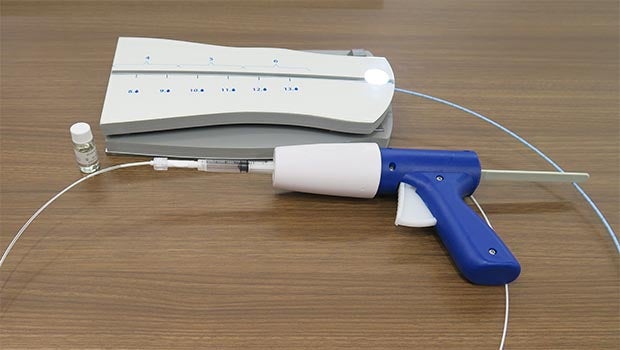
The applicator delivers medical-grade superglue or cyanoacrylate in precise quantities through a catheter in the patients' problem vein. Cyanoacrylate has been used in a wide variety of surgeries and wound treatments since the 1950s.
The scraggly veins on the leg may look unsightly. But more than just a cosmetic problem, varicose veins may indicate a more serious medical condition called chronic venous insufficiency (CVI).
People with CVI have veins that are damaged, causing blood to pool in the legs instead of flowing back to the heart. Dr Chong Tze Tec, Senior Consultant and Head, Department of Vascular Surgery, SGH, explained, "This causes a list of symptoms, starting from varicose veins which can progress to swelling in the ankles, pigmentation or eczema, to ulcers that are difficult to heal. But the most common symptoms reported by patients are heaviness and aching in their legs."
Conventional treatments for CVI include surgically stripping the veins, which leaves patients in pain for weeks after the procedure, or sealing the vein using heat (ablation) from radiofrequency or laser. This can be uncomfortable and exposes patients to risk of injury from the heat.
Now, a new procedure in Singapore General Hospital offers patients an elegant solution that is minimally invasive and allows them to return home and continue with normal activities right after. It involves a surgeon injecting medical-grade superglue called cyanoacrylate through a small catheter in the leg.
The specially-formulated cyanoacrylate is applied in precise quantities at various points in the problem vein, then the surgeon applies pressure to the leg for three minutes at each point to seal it. The whole procedure takes about one hour.

“There is minimal or no bruising at all and patients can resume their normal activities immediately without needing to wear compression stockings afterwards.”
– Dr Chong Tze Tec, Senior Consultant and Head, Department of Vascular Surgery, SGH
Dr Chong explained, "This is a good treatment option for the active or time-strapped Singaporeans. Treatment is simple, painless and fast – just glue, seal and put an adhesive bandage over a 3mm puncture in the leg. There is minimal or no bruising at all and patients can resume their normal activities immediately without needing to wear compression stockings afterwards."
A US study has shown that it has 99% success rate after three months, compared to 96% in radiofrequency ablation. Since SGH started offering it in 2016, more than 100 patients have undergone the treatment. SGH sees more than 300 patients with the condition each year.
The technology might sound simple but it brings great relief to patients. Dr Chong shared, "It is effective and patients are happy with the result. For many, it brings relief from years of aches and pains. After the procedure, I ask my patients if their legs feel lighter – and they always say yes!" he continued, "It's not about the cosmetic improvements. It's about a better quality of life."
People who are on their feet for long periods of time such as salespeople, hawkers and nurses, are more prone to varicose veins and CVI. Other risk factors include gender (women are at higher risk), older age, family history, obesity, deep vein thrombosis and pregnancy. One study suggests that around 30 per cent of varicose veins patients will have serious problems within six years if they do not have the problem seen to. Dr Chong said, "We see a number of nurses who suffer from varicose veins. They usually have knowledge about the condition and seek treatment early. But many people see it as just a cosmetic problem and part of the ageing process, so they only seek treatment when it has progressed to later stages." |















 Get it on Google Play
Get it on Google Play